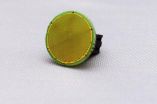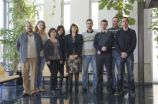(Press-News.org) JUPITER, FL, February 7, 2013 – Using two different compounds they developed, scientists from the Florida campus of The Scripps Research Institute (TSRI) have been able to show in animal models that inhibiting a specific enzyme protects heart cells and surrounding tissue against serious damage from heart attacks. The compounds also protect against additional injury from restored blood flow after an attack, a process known as reperfusion.
The study, which was led by Philip LoGrasso, a professor and senior scientific director of discovery biology at Scripps Florida, appears in the February 8, 2013 print edition of The Journal of Biological Chemistry.
A heart attack severely restricts blood supply, starving heart cells and surrounding tissue of oxygen, which can cause enormous damage in relatively little time—sometimes in just a few minutes. Known as an ischemic cascade, this drop-off of oxygen results in a sudden crush of metabolic waste that damages cell membranes as well as the mitochondria, a part of the cell that generates chemical energy and is involved in cell growth and death.
Unfortunately, restoring blood flow adds significantly to the damage, a serious medical issue when it comes to treating major ischemic events such as heart attack and stroke. Reperfusion re-invigorates production of free radicals and reactive oxygen species that attack and damage cells, exacerbating inflammation, turning loose white blood cells to attack otherwise salvageable cells and maybe even inducing potentially fatal cardiac arrhythmias.
The new study found that inhibiting the enzyme, c-jun-N-terminal kinase (JNK), pronounced "junk," protected against ischemic/reperfusion injury in rats, reducing the total volume of tissue death by as much as 34 percent. It also significantly reduced levels of reactive oxygen species and mitochondrial dysfunction.
In earlier studies, TSRI scientists found that JNK migrates to the mitochondria upon oxidative stress. That migration, coupled with JNK activation, they found, is associated with a number of serious health issues, including liver damage, neuronal cell death, stroke and heart attack. The peptide and small molecule inhibitor (SR3306) developed by LoGrasso and his colleagues blocks those harmful effects, thereby reducing programmed cell death four-fold.
"This is the same story," said LoGrasso. "These just happen to be heart cells, but we know that oxidative stress kills cells, and JNK inhibition protects against this stress. Blocking the translocation of JNK to the mitochondria is essential for stopping this killing cascade and may be an effective treatment for damage done to heart cells during an ischemic/reperfusion event."
In addition, LoGrasso said, biomarkers that rise during a heart attack shrink in the presence of JNK inhibition, a clear indication that blocking JNK reduces the severity of the infarction.
INFORMATION:
The first author of the study, "Inhibition of JNK Mitochondrial Localization and Signaling is Protective Against Ischemia-Reperfusion Injury in Rats," is Jeremy W. Chambers of TSRI. Other authors include Alok Pachori, Shannon Howard and Sarah Iqbal, also of TSRI. For more information, see http://www.jbc.org/content/early/2012/12/20/jbc.M112.406777.full.pdf
This work was supported by the National Institutes of Health (grant number NS057153) and by the Saul and Theresa Esman Foundation.
Compound developed by scientists protects heart cells during and after attack
2013-02-07
ELSE PRESS RELEASES FROM THIS DATE:
Social network use reflects East-West disparity
2013-02-07
EAST LANSING, Mich. — The stark contrast between America's "me-first" culture and the "collective-good" mentality in China is reflected in the two countries' use of social networking sites, according to a new study led by a Michigan State University scholar.
U.S. citizens spend more time on the networking sites, consider them to be more important and have more "friends" on the sites, the research found. The most popular social networking site in the United States is Facebook; in China it's Ozone.
Linda Jackson, MSU professor of psychology, said Chinese citizens tend ...
Health costs of income inequality in marriage, jealousy and parenting, humor and conflict
2013-02-07
In time for Valentine's Day, Personality and Social Psychology Bulletin is featuring several new studies all about relationships – including the link between income in marriage and health, the role of jealousy in becoming a parent, and how humor affects romantic couples in conflict.
Being the breadwinner has health costs
Men whose wives earn more income are more likely to use erectile dysfunction medication than those who outearn their wives, even when the inequality is small, according to a new study. Researchers looking at more than 200,000 married couples in Denmark ...
Smart satnav drives around the blue highway blues
2013-02-07
Endlessly frustrated by congested roads, computer scientists at California State University, in Fullerton have developed a satellite navigation system, GeoTNavi, which hooks into historical traffic data and current vehicle movements to find the shortest commute and avoid the traffic jams.
Writing in the latest issue of the International Journal of Data Mining, Modelling and Management, Shawn Wang and colleagues explain how the California highway system is one of the most complicated and busiest highway systems in the USA with well over 83% of urban interstate congestion. ...
Permanent stress can cause type 2 diabetes in men
2013-02-07
Men who reported permanent stress have a significantly higher risk of developing type 2 diabetes than men who reported no stress. This is the finding of a 35-year prospective follow-up study of 7,500 men in Gothenburg, by the University of Gothenburg, Sweden.
Since the 1970s, a large population based cohort study has been undertaken at the Sahlgrenska Academy, University of Gothenburg to monitor the health of men born in Gothenburg between 1915 and 1925.
Using this unique material, researchers are now able to show that permanent stress significantly increases the risk ...
A Spanish breakthrough allows the electroporation of cell cultures for less than 1 Euro
2013-02-07
Researchers from the Polytechnic University of Catalonia have developed a technique that improves and cuts the cost of a technique called electroporation, which involves opening pores in cell membranes using an electric field to introduce substances like drugs and DNA. Current methods are aggressive and expensive whereas the new system manages to apply low voltage electroporation with a small printed circuit board, which costs less than a Euro per unit and does not damage cells.
Two US firms in Boston and San Francisco operating in the biotechnology equipment sector have ...
Asians are far more likely than Anglos to be college-educated
2013-02-07
Asians (about 60 percent) are much more likely to be college-educated than Anglos (under 40 percent), according to Rice University's Kinder Institute Houston Area Asian Survey, the first systematic look at the local Asian population based on three surveys conducted over a 16-year period. The findings were released today by Stephen Klineberg, Kinder Institute co-director and Rice sociologist, at an event hosted by the institute at the Asia Society Texas Center.
The surveys, conducted in 1995, 2002 and 2011 in conjunction with the annual Kinder Institute Houston Area Survey, ...
Research could ensure that crowd work becomes a career option, not a dead end
2013-02-07
PITTSBURGH—Crowdsourcing is an effective way to mobilize people to accomplish tasks on a global scale, but some researchers fear that crowd work for pay could easily become the high-tech equivalent of a sweat shop. Trivial work for rock bottom pay isn't inevitable, however, and they've outlined a research agenda to make crowd work both intellectually and monetarily rewarding.
Leading researchers in crowd work from Carnegie Mellon University and other institutions will present their plan, hashed out in a special workshop last spring, at the Association for Computing Machinery's ...
Veterans with mild traumatic brain injury have brain abnormalities
2013-02-07
Mild traumatic brain injury (TBI), including concussion, is one of the most common types of neurological disorder, affecting approximately 1.3 million Americans annually. It has received more attention recently because of its frequency and impact among two groups of patients: professional athletes, especially football players; and soldiers returning from mid-east conflicts with blast-related TBI. An estimated 10 to 20 percent of the more than 2 million U.S. soldiers deployed in Iraq or Afghanistan have experienced TBI.
A recent study by psychiatrists with the Iowa City ...
A privacy risk in your DNA
2013-02-07
The growing ease of DNA sequencing has led to enormous advancements in the scientific field. Through extensive networked databases, researchers can access genetic information to gain valuable knowledge about causative and preventative factors for disease, and identify new targets for future treatments. But the wider availability of such information also has a significant downside — the risk of revealing personal information.
Researchers from Tel Aviv University and the Whitehead Institute of Biomedical Research in Cambridge, MA, have developed an algorithm that can identify ...
UAB researchers cure type 1 diabetes in dogs
2013-02-07
Researchers from the Universitat Autònoma de Barcelona (UAB), led by Fàtima Bosch, have shown for the first time that it is possible to cure diabetes in large animals with a single session of gene therapy. As published this week in Diabetes, the principal journal for research on the disease, after a single gene therapy session, the dogs recover their health and no longer show symptoms of the disease. In some cases, monitoring continued for over four years, with no recurrence of symptoms.
The therapy is minimally invasive. It consists of a single session of various injections ...



